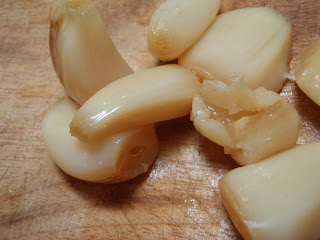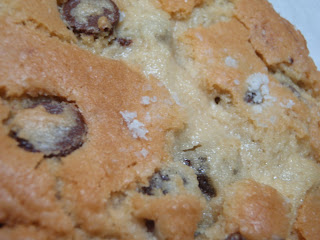Friday, November 26, 2010
Roasted Garlic
Monday, November 22, 2010
Pumpkin Panna Cotta
Think of this as a pumpkin pie alternative... a crustless, cool and creamy pumpkin (egg-free) custard.
Saturday, November 20, 2010
Barley and Pine Nut Pilaf
In a 10-inch skillet, heat butter and brown pine nuts. Remove with a slotted spoon and reserve. Saute green onions and barley until lightly toasted. Remove the pan from heat. Stir in toasted nuts, parsley, salt, and pepper. Spoon into ungreased 2 qt. casserole.
Monday, November 15, 2010
Apple and Cheddar Scones
I saw these and had to try them.
I'm not an advocate for using a mixer when making scones. I think it needs to be done by hand for textural reasons in the finished product. Besides, it's not that much of an inconvenience!
Thursday, November 11, 2010
"The PERFECT Chocolate Chip Cookies"
However, you can sort of justify it mentally by telling yourself you won't be eating ALL of those cookies. And besides, how often are you really going to make them since you have to wait a forever long time before you get to the finished product? It's ok. Right?
The salt is also kind of pretty- it adds a little crystalline sparkle.
They're probably more appreciated by adults than kids, and better for people who like to temper their sweet with a little savory.
The Perfect Chocolate Chip Cookies
Yield: 2 dozen 4-inch cookies
Adapted from Jacques Torres
3 1/2 cups AP flour
1 1/4 t baking soda
1 1/2 t baking powder
1 1/2 teaspoons coarse salt (such as kosher)
2 1/2 sticks (1 1/4 cups) unsalted butter
1 1/4 c lightly packed light brown sugar
1 c plus 2 tablespoons granulated sugar
2 large eggs
2 teaspoons vanilla extract
16 oz bittersweet or semi-sweet chocolate chips, disks or fèves, at least 60 percent cacao content (if possible)
Sea salt or kosher salt, for sprinkling
Sift flours, baking soda, baking powder and salt into a bowl and set aside.
Using a mixer fitted with paddle attachment, cream butter and sugars together until very light, about 5 minutes. Add eggs, one at a time, mixing well after each addition. Stir in the vanilla. Reduce speed to low, add dry ingredients and mix until just combined, 5 to 10 seconds. Drop chocolate pieces in and incorporate them, stirring by hand, without breaking them. Transfer the dough to another bowl, press plastic wrap directly against the dough, and refrigerate for 24 to 36 hours. Dough may be used in batches, and can be refrigerated for up to 72 hours.
*Before baking the cookies, it will be easier to deal with the cold dough if you leave the bowl out at room temperature for about 30 minutes. You still want the dough to be cool before baking though!
Preheat oven to 350 degrees. Line a baking sheet with parchment paper or a nonstick baking mat. Set aside.
Scoop mounds of dough onto baking sheet with an ice cream scoop (about 1/4 c of dough, or 4 oz. if you have a scale), making sure to turn horizontally any chocolate pieces that are poking up; it will make for a more attractive cookie. Sprinkle lightly with sea salt or kosher salt and bake until golden brown but still soft, 15 to 18 minutes, rotating the baking sheet front to back halfway through. Transfer the sheet with the cookies to a wire rack for 10 minutes, then slip cookies on the parchment paper onto another rack to cool a bit more. Repeat with remaining dough, or reserve dough, refrigerated, for baking remaining batches the next day. Eat warm, with a big napkin.

































































